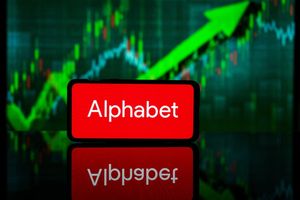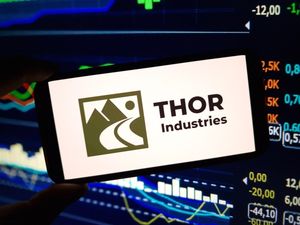
In a significant shift that could redefine the institutional crypto landscape, Wall Street funds are increasingly eyeing XRP as a "dark horse" contender, drawing parallels to Bitcoin's (BTC) early institutional journey. This burgeoning interest, primarily fueled by a wave of recent Exchange-Traded Fund (ETF) filings and the definitive resolution of Ripple Labs' protracted legal battle with the U.S. Securities and Exchange Commission (SEC), signals a profound change in institutional perception towards the digital asset. As of September 25, 2025, XRP is no longer merely a speculative asset but is rapidly solidifying its position as a legitimate, regulated instrument within traditional finance.
The re-entry of XRP into the institutional spotlight, particularly through regulated investment vehicles, marks a pivotal moment for the broader digital asset market. This move not only legitimizes XRP in the eyes of traditional investors but also paves the way for a new era of altcoin adoption by mainstream financial players. The implications are vast, promising increased liquidity, enhanced market stability, and potentially significant capital inflows into an asset once shrouded in regulatory uncertainty.
XRP's Ascent: From Legal Limbo to Institutional Legitimacy
The journey of XRP from a controversial digital asset to a Wall Street darling has been tumultuous, yet transformative. For nearly five years, the shadow of the SEC lawsuit against Ripple Labs (XRP) cast a long pall over XRP, deterring institutional engagement and leading to delistings from various exchanges. However, a series of pivotal events, culminating in regulatory clarity and a flurry of ETF activity, has dramatically altered its trajectory.
The most significant catalyst was the resolution of the SEC vs. Ripple lawsuit. Initiated on December 22, 2020, the lawsuit alleged that XRP sales constituted an unregistered securities offering. A landmark ruling on July 13, 2023, by Judge Analisa Torres, determined that programmatic sales of XRP on public exchanges were not unregistered securities, while direct institutional sales did constitute investment contracts. This mixed ruling was largely seen as a partial victory for Ripple. The SEC initially pursued an appeal, but in March 2025, it formally ended its appeal, a move hailed as a "resounding victory" by Ripple CEO Brad Garlinghouse. By August 2025, the legal saga definitively concluded with Ripple and the SEC mutually dismissing their appeals, cementing Judge Torres's 2023 split ruling as the final word. Ripple paid a $125 million penalty to the U.S. Treasury, a significant reduction from the SEC's initial demand, and its executives were cleared of personal liability. This resolution provided crucial regulatory clarity, removing the primary impediment to institutional adoption.
Following this newfound clarity, a wave of ETF filings and approvals has swept through the market. In September 2024, Grayscale Investments (OTCQX: GBTC) launched its Grayscale XRP Trust, a closed-end fund. By January 2025, Grayscale filed to convert this trust into a spot ETF. The ProShares Ultra XRP ETF, a 2x leveraged futures-based fund, was approved and began trading on NYSE Arca in July 2025. A monumental moment arrived on September 18, 2025, when the first U.S.-based spot XRP ETF, the REX-Osprey XRP ETF (XRPR), debuted on Nasdaq, recording a notable $37.7 million in first-day trading volume, marking it as the largest ETF launch of the year. Just days later, on September 22, 2025, Grayscale's XRP ETF also received approval. Today, September 25, 2025, the SEC approved the Hashdex Nasdaq Crypto Index US ETF to hold XRP, which now represents 7.11% of its portfolio alongside Bitcoin (BTC), Ethereum (ETH), Solana (SOL), and Stellar (XLM). Numerous other major asset managers, including Franklin Templeton, 21Shares, Bitwise, WisdomTree, CoinShares, and Canary Capital, have pending spot XRP ETF applications, with final SEC decisions expected between October 18 and November 14, 2025.
Key players driving this institutional shift include Ripple Labs, led by CEO Brad Garlinghouse; asset managers such as Grayscale Investments (OTCQX: GBTC), REX-Osprey, Hashdex, Bitwise, 21Shares, Franklin Templeton (NYSE: BEN), WisdomTree (NASDAQ: WT), CoinShares, Canary Capital, and ProShares; and traditional financial institutions like Santander, Bank of America (NYSE: BAC), SBI Holdings, DBS, and Franklin Templeton (NYSE: BEN) that are either partnering with Ripple or exploring its technology. The market's reaction has been overwhelmingly positive. XRP's price surged 87% in July 2023 following the partial victory and jumped 11% to $3.30 in August 2025 upon the lawsuit's final resolution, with institutional trading volume spiking 208%. The strong debut of the REX-Osprey XRP ETF further demonstrated robust initial demand for regulated XRP exposure. Analysts are now bullish, predicting XRP could break above $3.00, with some targeting $4.00 and beyond in the near term.
The Winners and Losers in XRP's Institutional Embrace
The institutionalization of XRP is poised to create distinct winners and losers across the financial ecosystem, impacting business models, revenues, and market positions.
Crypto Exchanges and Trading Platforms are among the clearest beneficiaries. CBOE Global Markets (CBOE), already profiting from the listing and trading of the REX-Osprey XRP ETF (XRPR), will see increased transaction fees and market data revenue from further ETF approvals. CME Group (CME), which plans to offer options on XRP futures starting October 13, 2025, will expand its product offerings and attract institutional traders, boosting its derivatives trading volume. Coinbase Global, Inc. (NASDAQ: COIN), as a major exchange, stands to gain from increased liquidity, potential new listing fees, and demand for its custody services from ETF issuers, strengthening its overall position in the crypto market.
Asset Management Firms are at the forefront of this shift. Hashdex, with its Nasdaq Crypto US ETF already approved to hold XRP, gains a first-mover advantage. REX-Osprey, having launched the largest ETF debut of 2025 with XRPR, secures a significant lead in the XRP ETF market, boosting its Assets Under Management (AUM) and management fees. Grayscale Investments (OTCQX: GBTC), with its XRP ETF recently approved and XRP included in its Digital Large Cap Fund, will see a substantial increase in AUM as it converts trusts into spot ETFs. Firms like Franklin Templeton (NYSE: BEN), 21Shares, Bitwise, CoinShares, Canary Capital, and WisdomTree (NASDAQ: WT), with pending XRP ETF applications, stand to diversify their crypto offerings, attract new institutional clients, and significantly grow their AUM and management fees upon approval. Even giants like BlackRock (NYSE: BLK) and VanEck, while not directly offering XRP ETFs yet, are integrating Ripple's RLUSD stablecoin with their tokenized funds (BlackRock's BUIDL and VanEck's VBILL), indicating a growing embrace of digital assets.
In Traditional Finance and Payment Providers, some are strategically aligning with Ripple. BNY Mellon (NYSE: BK), appointed as the primary custodian for Ripple's RLUSD stablecoin, is deepening its involvement in digital assets, potentially expanding custody services for other XRP-related products. Canadian Imperial Bank of Commerce (NYSE: CIBC), which expanded its alliance with Ripple in July 2025, uses RippleNet with XRP's On-Demand Liquidity (ODL) for cross-border payments, leading to improved efficiency and potential cost savings. SBI Remit & SBI Holdings (TYO: 8473) in Japan, leveraging XRP for remittances and planning to introduce RLUSD, enhances their cross-border payment efficiency. Other payment companies like Tranglo, Pyypl, BeeTech, and Travelex Bank, which have adopted XRP (ODL), directly benefit from its near-instant settlement and lower transaction costs, improving their competitiveness in the remittance market.
Conversely, Traditional Remittance Companies heavily reliant on older, slower, and more expensive infrastructures, such as Western Union (NYSE: WU), face substantial competitive pressure. Without integrating blockchain-based solutions or partnering with innovators, they risk losing market share to more efficient XRP-powered alternatives. Similarly, Banks Heavily Dependent on Nostro/Vostro Account Systems could see their traditional correspondent banking revenue diminish. While many banks partner with RippleNet without directly using XRP, the opportunity cost of not fully embracing XRP for ODL could impact long-term profitability and operational efficiency. The market is actively experiencing these shifts, with proactive companies realizing benefits and those clinging to legacy systems facing growing competitive threats.
A Wider Web of Significance: Trends, Ripples, and Regulatory Shifts
The institutional embrace of XRP extends far beyond the asset itself, reflecting and accelerating broader industry trends, creating ripple effects, and establishing critical regulatory precedents for the entire digital asset space.
This event fits squarely into the accelerating trend of institutional crypto adoption. As of mid-2025, 71% of institutional investors have invested in digital assets, with AUM by institutions surpassing $235 billion. The approval of Bitcoin (BTC) spot ETFs in January 2024 and Ethereum (ETH) spot ETFs in July 2024 set a powerful precedent, attracting billions in capital. XRP's institutionalization signals that this trend is expanding beyond the top two cryptocurrencies, validating a wider array of digital assets. Furthermore, it aligns with the booming tokenization market, projected to reach $4.1 billion in 2025 and over $5 trillion by 2029 for global asset tokenization. Ripple's focus on the XRP Ledger (XRPL) as an institutional backbone for tokenized finance and cross-border Central Bank Digital Currency (CBDC) transactions positions XRP as a key player in the tokenization of real-world assets (RWAs), a market expected to grow from $0.6 trillion in 2025 to $18.9 trillion by 2033.
The ripple effects are significant. For competitors like Stellar (XLM), also focused on cross-border payments, XRP's enhanced institutional legitimacy through ETFs intensifies competition. While Ripple targets established financial institutions, Stellar emphasizes individual users and a decentralized network. However, the inclusion of XLM in multi-asset ETFs alongside XRP suggests that a rising tide of altcoin institutionalization may benefit multiple projects. For traditional finance partners of Ripple, XRP ETFs offer a more regulated and liquid means to engage with XRP, potentially driving further adoption of RippleNet's On-Demand Liquidity (ODL) service and fostering more efficient cross-border payments.
Critically, the SEC's decision on September 17, 2025, to approve generic listing standards for commodity-based Exchange-Traded Products (ETPs) has monumental regulatory implications for other altcoins. This new framework streamlines approvals, potentially accelerating the launch of other altcoin-based ETFs and cutting approval timelines to less than 75 days. This signals a clear shift in regulatory posture, suggesting increased openness towards assets like Solana (SOL), Cardano (ADA), Litecoin (LTC), and Dogecoin (DOGE). The approval of multi-crypto ETPs like Grayscale's Digital Large Cap Fund, which includes various altcoins, indicates growing acceptance of diversified digital asset investment vehicles. This U.S. regulatory shift also aligns with global trends, such as Europe's Markets in Crypto-Assets Regulation (MiCA), which became fully operational in January 2025, fostering confidence and growth in digital finance worldwide.
Historically, XRP's journey draws parallels with Bitcoin's, yet with key divergences. Both faced prolonged regulatory scrutiny, but XRP's multi-year lawsuit provided a unique, definitive legal clarity (declassifying it as a non-security in secondary sales) before widespread spot ETF approvals, whereas Bitcoin's legal clarity was generally assumed. Bitcoin's spot ETF approval in January 2024 dramatically lowered barriers to entry, and XRP ETFs are expected to replicate this effect, drawing significant institutional capital. The rapid succession of XRP ETF approvals, following Bitcoin and Ethereum, and the SEC's new generic listing standards, demonstrate an accelerated regulatory acceptance for major altcoins, suggesting a faster integration timeline for other digital assets into traditional finance compared to the protracted process Bitcoin endured.
What Comes Next: A Glimpse into XRP's Future
The institutionalization of XRP is setting the stage for a dynamic future, marked by continued integration into global finance and evolving market dynamics.
In the short-term, the market anticipates the approval of additional XRP ETFs in mid to late October 2025, from issuers like Grayscale, Bitwise, and Franklin Templeton. While immediate sharp price surges on approval days are unlikely, these approvals are expected to build Assets Under Management (AUM) gradually, with significant ETF trading and market inflows potentially ramping up in winter 2025. Analysts are bullish, projecting XRP could rally towards $3.00-$3.40 by Q3 2025, with more aggressive targets of $4.43-$7.90 if strong support levels are maintained. The CME Group's offering of options on XRP futures starting October 13, 2025, will further enhance institutional liquidity and hedging opportunities.
For the long-term, XRP aims to solidify its position as a leading digital asset for global payments and a crucial bridge between traditional and digital financial systems. Forecasts for 2030 range widely, from conservative estimates of $4.67 to highly optimistic projections surpassing $26, or even $50-$100, contingent on its dominance in cross-border payments and the evolution of the XRP Ledger (XRPL). Ripple's strategic pivots include expanding its On-Demand Liquidity (ODL) service into high-growth corridors, enhancing the XRPL with features like a native lending protocol and zero-knowledge proof (ZKP) capabilities, and deepening the integration of its Ripple USD (RLUSD) stablecoin into tokenized asset platforms. Ripple's acquisition of prime brokerage firm Hidden Road and partnerships with entities like the Dubai Land Department for real estate tokenization underscore its commitment to embedding XRP deeper into global finance.
Market opportunities are vast. XRP is poised to disrupt the $156 trillion cross-border payments market with its faster settlement times and significantly lower fees. The XRPL is becoming a platform for tokenizing real-world assets, a market projected to hit $16 trillion by 2030. XRP's Shariah compliance approval opens doors to substantial remittance flows in the Gulf region. Furthermore, Ripple CEO Brad Garlinghouse confirmed XRP's inclusion in the U.S. government's digital assets stockpile, highlighting growing legitimacy. However, challenges persist. Incomplete global regulatory clarity outside the U.S. remains a hurdle. XRP faces intense competition from other blockchain projects and traditional payment systems. Its operational success is still largely tied to Ripple Labs' performance, and the increasing role of Ripple's own stablecoin (RLUSD) could potentially divert utility away from XRP, impacting its price appreciation.
Potential scenarios range from a bullish outcome of widespread adoption for cross-border payments, numerous ETF approvals, and significant institutional capital inflows driving XRP's price to higher targets, to a moderate growth scenario with steady ODL usage and partnerships. A slower adoption scenario could see growth limited by global regulatory ambiguities, intense competition, and the tendency of institutions to use XRP as a momentary bridge asset rather than a long-term holding. Overall, the narrative surrounding XRP has fundamentally transformed. The confluence of regulatory clarity, the launch and anticipated approvals of ETFs, and Ripple's strategic focus on institutional utility positions XRP at a pivotal crossroads, signaling a new era of institutional engagement in the digital asset economy.
Comprehensive Wrap-up: A New Era for Digital Assets
The emergence of XRP as a "dark horse" on Wall Street, propelled by significant ETF approvals and the definitive resolution of its legal battle with the SEC, marks a profound and irreversible shift in the financial markets. This event is not merely about one digital asset; it symbolizes the accelerating maturation and institutional acceptance of the broader cryptocurrency ecosystem.
Key takeaways include the critical importance of regulatory clarity in unlocking institutional capital, the increasing demand for regulated crypto investment products, and the growing recognition of digital assets like XRP for their real-world utility in transforming traditional financial services. The SEC's new generic listing standards for commodity-based ETPs, effective as of September 17, 2025, establish a clear and expedited pathway for other altcoins to follow in XRP's footsteps, fundamentally reshaping the future of crypto ETFs.
Moving forward, the market is poised for continued integration of digital assets into traditional finance. The initial success of XRP ETFs, coupled with anticipated further approvals, suggests a gradual yet substantial flow of institutional capital into the asset class. This will likely lead to enhanced liquidity, reduced volatility, and more robust price discovery for XRP. Ripple's strategic focus on expanding its On-Demand Liquidity (ODL) network, enhancing the XRP Ledger (XRPL) for tokenized assets, and integrating its RLUSD stablecoin will be crucial determinants of XRP's long-term utility and value.
The lasting impact of this development will be the establishment of a more legitimate and accessible digital asset market for institutional investors. It validates the vision of blockchain technology as a foundational layer for future financial infrastructure, particularly in cross-border payments and asset tokenization. This paves the way for a more efficient, transparent, and interconnected global financial system.
Investors should watch for several key indicators in the coming months: the outcomes of pending XRP ETF applications in October and November 2025; the growth in Assets Under Management (AUM) for existing XRP ETFs; the expansion of Ripple's ODL corridors and strategic partnerships; and any further regulatory developments concerning other altcoins. The integration of XRP into traditional derivatives markets, such as CME Group's options on XRP futures, will also be a critical sign of deepening institutional embrace. While volatility remains an inherent characteristic of digital assets, the current trajectory suggests that XRP is firmly on a path toward greater institutional adoption and utility, positioning it as a significant player in the evolving digital economy.
This content is intended for informational purposes only and is not financial advice





